
Rubus phoenicolasius is an Asian species of raspberry in the rose family, native to China, Japan, and Korea.

Maianthemum racemosum, the treacleberry, feathery false lily of the valley, false Solomon's seal, Solomon's plume or false spikenard, is a species of flowering plant native to North America. It is a common, widespread plant with numerous common names and synonyms, known from every US state except Hawaii, and from every Canadian province and territory, as well as from Mexico.

Triodanis is a genus of flowering plants within the family Campanulaceae, native to North and South America. Venus' looking-glass is a common name for plants in this genus.

Allium cernuum, known as nodding onion or lady's leek, is a perennial plant in the genus Allium. It grows in open areas in North America.
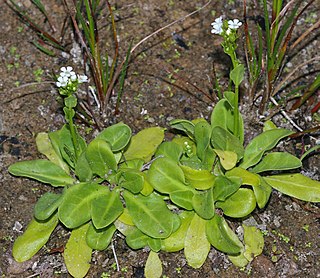
Samolus valerandi is a species of flowering plant in the primrose family Primulaceae. Common names include seaside brookweed, brookweed, thin-leaf brookweed, water cabbage, and water rose.

Ribes aureum, known by the common names golden currant, clove currant, pruterberry and buffalo currant, is a species of flowering plant in the genus Ribes native to North America.

Polygonum erectum, commonly called erect knotweed, is a North American species of herbaceous plant in the buckwheat family (Polygonaceae). It is found primarily in the northeastern and north-central parts of the United States, but with scattered populations in other parts of the US and also in Canada.

Solidago rugosa, commonly called the wrinkleleaf goldenrod or rough-stemmed goldenrod, is a species of flowering plant in the family Asteraceae. It is native to North America, where it is widespread across eastern and central Canada and the eastern and central United States. It is usually found in wet to mesic habitats.

Triodanis perfoliata, the clasping Venus' looking-glass or clasping bellflower, is an annual flowering plant belonging to the family Campanulaceae. It is an annual herb native to North and South America, the natural range extending from Canada to Argentina. It is also naturalized in China, Korea and Australia.

Triodanis biflora is a species of flowering plant native to the Americas and known commonly as small Venus' looking-glass. The flower is solitary and has a bell-shaped blue or purple corolla. Its leaf arrangement is alternate and its leaf type is simple. Its leaves are thin, serrate and sessile.
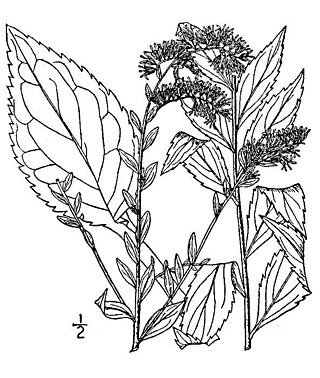
Solidago ulmifolia, commonly known as elmleaf goldenrod, is a North American species of goldenrod in the family Asteraceae. It is found in Canada and the eastern and central United States.

Fimbristylis puberula, commonly called hairy fimbry, is a species of flowering plant in the sedge family (Cyperaceae). It is native to North America, where it has a widespread, but patchy, distribution. The largest populations are in the Southeastern Coastal Plain and the eastern Great Plains. Its natural habitat is in prairies, savannas, and glades. It can be found on both basic and acidic soil.

Ammoselinum butleria, commonly called the Butler's sandparsley, is a species of flowering plant in the carrot family (Apiaceae). It is native to North America, where it is found primarily in the South Central United States. It is most often found in disturbed sandy areas, including lawns. Its range has expanded eastward in recent times, leading some authorities to consider populations east of the Mississippi River to be non-native.

Borodinia dentata, commonly called Short's rockcress, is a species of flowering plant in the mustard family (Brassicaceae). It is native to the eastern North America, where it is found in Canada and the United States. In the United States, its range is primarily centered in the Midwest, and in Canada it is only known from Ontario. Its natural habitat is in nutrient-rich alluvial forests and loamy bluffs, often on calcareous substrate.

Rhynchospora rariflora, commonly called fewflower beaksedge, is a species of flowering plant in the sedge family (Cyperaceae). It is native to North America, where it is found in the southeastern United States, Mexico, Belize, Honduras, Nicaragua, and the West Indies. Its typical natural habitat is sandy or peaty areas, in wet savannas, seeps, and bogs.
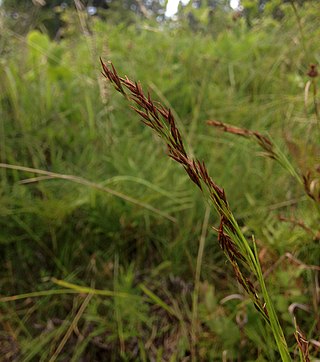
Rhynchospora inexpansa, commonly called nodding beaksedge, is a species of flowering plant in the sedge family (Cyperaceae). It is native to North America, where it is found in the southeastern United States and West Indies. Its typical natural habitat is in moist meadows, flatwoods, and pond edges. It is a weedy species that responds positively to ecological disturbance.

Acalypha monococca, commonly called slender threeseed mercury, is a species of flowering plant in the spurge family (Euphorbiaceae). It is native to North America, where it is found in the South Central and Midwestern regions of the United States, primarily west of the Mississippi River. Its natural habitat is in dry, sunny, sandy or rocky areas, in prairies, barrens, or woodlands.
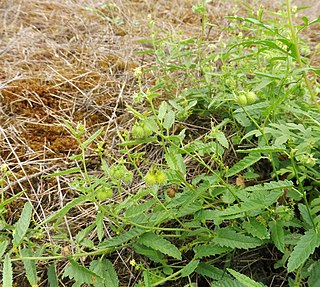
Tragia betonicifolia, commonly called betonyleaf noseburn, is a species of flowering plant in the spurge family (Euphorbiaceae). It is native to North America, where it is primarily found in the South-Central region of the United States extending north into Kansas and Missouri, with disjunct populations east in Tennessee. Its typical natural habitat is dry areas with sandy or rocky soil, in glades, prairies, bluffs, and dry woodlands.

Panicum flexile, commonly called wiry panicgrass, is a species of flowering plant in the grass family (Poaceae). It is primarily native to eastern to North America, where it has a scattered and localized distribution. It is typically found in mafic or calcareous open areas, both wet and dry, particularly associated with limestone.
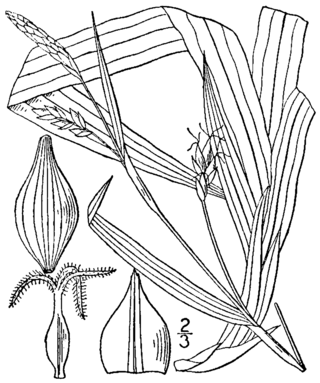
Carex careyana, commonly known as Carey's sedge, is a species of sedge found in the eastern United States and Ontario, Canada.




















